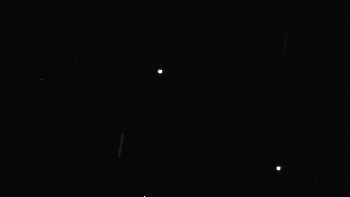A Russian military satellite called Luch-2 was found making a close approach to a geostationary satellite last month, a maneuver that follows in the footsteps of its predecessor that was found eavesdropping on other nations’ satellites on multiple occasions since 2014.
Aldoria, a French startup that tracks satellites in orbit using a network of ground-based telescopes, notified satellite operators in May 2024 that it had detected “an unexpected close approach” by the Russian Luch-2 to a satellite positioned in geostationary orbit. The maneuver by Luch-2 took place on April 12, 2024 about 22,232 miles (35,780 kilometers) from Earth’s surface, the company said in a STATEMENT .
Aldoria did not reveal what satellite Luch-2 may have spied or exactly how close it came to the object. The minimum distance between the two objects was 6.2 miles (10 kilometers), while today (June 3) they are about 12 to 30 miles (20 to 50 kilometers), Saloua Moutaoufik, Aldoria’s public relations manager, told Space. com. email.
Connected: Pentagon space chief condemns ‘irresponsible’ launch of Russian inspector satellite
News of the narrow approach comes shortly after US intelligence officials and the Pentagon accused Russia of trying to militarize space by placing a different military inspector satellite in the same orbit as a US government satellite.
The Russian satellite, Cosmos 2576, is likely an anti-space weapon that is supposedly capable of attacking other satellites in low Earth orbit, US Ambassador Robert Wood said on May 20 during a UN Security Council meeting . Russian Deputy Foreign Minister Sergey Ryabkov has denied Pentagon claims as fake news.
Meanwhile, the Russian Luch-2, otherwise known as Olymp-2, started secretly in March 2024 and in October of that year moved within 37 miles (60 kilometers) of another geostationary spacecraft. By early December, it had left this position and drifted off to another satellite, according to autonomous monitoring by Slingshot Aerospace a space data analytics firm that focuses on spaceflight safety.
In both cases, Slingshot did not identify the satellites, but company representatives told SpaceNews that the information may be useful to satellite operators concerned about safety in space.
The Luch-2’s recent maneuvers are not unprecedented when it comes to the behavior of the Russian ship. The satellite’s predecessor, Luch-1, was a known intruder found near other countries’ satellites on numerous occasions, including in 2015 when it sparked international concern after being parked directly between two Intelsat satellites for five months, sometimes maneuvering in about 6.2 miles (10 kilometers) of US spacecraft.
While Intelsat officials said at the time that the Russian satellite did not interfere with their satellite services, this was the first publicly documented incident of a commercial operator being approached by a foreign military satellite. SpaceNews reported . In 2018, France accused Russia use of Luch-1 to try and intercept communications from one of the country’s satellites used for military purposes, calling it “not only unfriendly, but an act of espionage”.
A ANALYSIS by an American non-profit institute found that Luch-1 had ridden between at least 19 different points around the geostationary belt since 2020. Such maneuvers by Luch-1, which Russia launched in 2014, created “a heightened sense vigilance within the community space,” Aldoria said in last week’s announcement.
“Luch-2, like its predecessor, has a history of unusual maneuvering near other satellites in geostationary orbit, which has also raised doubts about its mission,” the company wrote.
